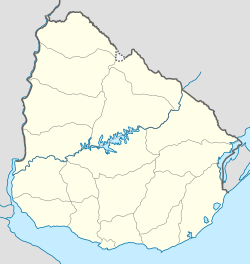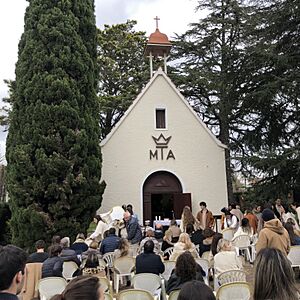Nueva Helvecia facts for kids
Quick facts for kids
Nueva Helvecia
|
|
|---|---|
|
City
|
|
| Country | |
| Department | |
| Founded | 1862 |
| Population
(2011 Census)
|
|
| • Total | 10,630 |
Nueva Helvecia (Spanish for "New Helvetia"; formerly known as Colonia Suiza) is a city in the Colonia Department of Uruguay. It is about 120 kilometers (75 miles) west of Montevideo, Uruguay's capital city. Nueva Helvecia is well-known throughout Uruguay for its strong Swiss heritage and traditions.
Contents
History of Nueva Helvecia
Why Swiss People Came to Uruguay
In the mid-1800s, many people in Europe faced difficult economic times. The Industrial Revolution changed how many small businesses and family workshops worked. Also, Swiss mercenary soldiers could no longer fight for other countries. They returned home to find their families struggling.
The Americas offered a chance for a better future. Many Swiss people first went to North America, especially during the California Gold Rush. But when the American Civil War started in the United States, Swiss emigrants began looking further south. They considered Argentina, Brazil, and Uruguay.
In Brazil, foreigners could not own land. In Argentina, settlers sometimes faced problems with local people. However, Uruguay's government had an open policy for immigrants. They wanted to populate the country, which had very few people at the time. The Swiss colony in Uruguay was given freedom to govern itself. The first secret democratic vote in Uruguay even happened in Colonia Suiza. Swiss immigrants helped shape many Uruguayan laws. This is one reason why Uruguay is sometimes called the "Switzerland of the Americas." They also brought the classic way of making Swiss cheese, known as "Queso Colonia."
Founding the Settlement
The first Swiss settler was David Salomon Bratschi from Bern. He arrived in 1858. This was three years before the first large group of settlers came at the end of 1861.
The official founding day of Nueva Helvecia is April 24, 1862. On this date, many immigrants settled in the area. Most were from Switzerland, but many also came from Austria, Germany, Italy, and France. This European immigration led to the creation of towns like Colonia Suiza, Colonia Valdense, Colonia Miguelete, and Rosario. The name "Nueva Helvecia" was given to "Colonia Suiza" some decades later.
The arrival of these immigrants was very important for Uruguay. It helped shape the country's political system. Uruguay offered good land for farming and raising animals.
Culture and Traditions
The people of Nueva Helvecia have kept many Swiss traditions and customs alive. Groups like "Los Alegres Alpinos" and "Alpenveilchen Grupo de Danzas" still perform the songs and dances of their ancestors.
However, today, very few people in Nueva Helvecia speak the original languages of their ancestors. This is partly because people from different backgrounds married each other. Even among Swiss immigrants, different dialects made it hard to communicate. So, they often used the Spanish language to talk to each other.
The city celebrates several holidays and festivals:
- The 25th of April: This day celebrates the anniversary of Nueva Helvecia's founding.
- The 1st of August: This day marks the anniversary of the formation of the Swiss Confederation.
- The "Bierfest": This festival in December attracts visitors from other parts of Uruguay and from other countries.
Architecture of Nueva Helvecia
Even though Nueva Helvecia is in Uruguay, its buildings look a lot like older European architecture. You can see styles from Switzerland, Germany, and France. This shows the city's strong connection to those cultures. Unlike other cities in Uruguay, many buildings in Nueva Helvecia have a special shield. This shield represents the different Swiss regions (cantons) where the families living in the house originally came from. This tradition has become even more noticeable in recent years.
Places to Visit
- Plaza de los Fundadores (Founders' Plaza)
- Tiro Suizo (Swiss Shooting Club)
- Hotel Suizo (Swiss Hotel)
- OSE Watertank
- Molino Quemado (Burned Mill)
- Evangelical Congregation of Nueva Helvecia (Evangelical Church of the River Plate)
- Most Holy Trinity Parish Church (Roman Catholic)
- Our Lady of Schoenstatt Chapel, a popular Roman Catholic pilgrimage site
- Cine Helvético (Helvetic Cinema)
Economy of Nueva Helvecia
The city's economy mainly focuses on dairy products. These include milk, Swiss cheese, cream cheese, dulce de leche, and yogurt. Nueva Helvecia also produces various sausages and other animal products. Farmers here also grow fruits, vegetables, cereals, and make wine.
Notable People
- Franco Israel, (born 2000), professional football player
- Pedro Ignacio Wolcan Olano, (born 1953) bishop of Tacuarembó
- Rodrigo Bentancur (born 1997), association football player
- Jorge Meyer Long (born 1949), diplomat
- Horacio Troche (1935-2014), association football player and trainer
- Nibia Sabalsagaray (1949-1974), educator
See also
 In Spanish: Nueva Helvecia para niños
In Spanish: Nueva Helvecia para niños



